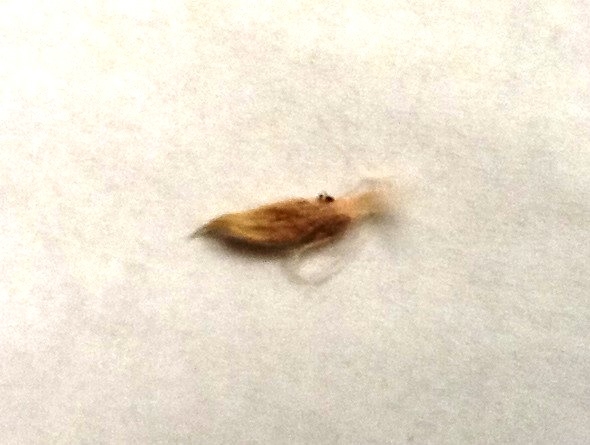Posts Tagged: pets
Foxtails are to be feared! Scientific name: Hordeum jubatum (Grass Family: Poaceae)
Recently I had the displeasure of experiencing just how feisty foxtails can be! I’ve heard people say that they are to be avoided, but it wasn’t until my sweet puppy got one lodged in her paw last week that I realized just how dangerous they can be.
On first glance foxtails seem pretty harmless, actually resembling small stalks of wheat. But upon closer inspection, you can see that the bristly flowering head is a spike that ranges from 1-1/5 to 4 inches (3–10 cm) in length. Long needlelike awns, up to 1/3 of an inch, extend from the spike, and are barbed in such a way that ensures they travel in only one direction —in deeper and deeper. These nasty weeds grow in abundance throughout California and are reported in most every state west of the Mississippi
And beware, these foxtails are nearly everywhere, not just on hiking trails or pastures as one would naturally assume. I though our local elementary school soccer field would give my active puppy a lot of room to run, but still keep her safe from hazards. Oh was I wrong!!
She loves grass like no other dog I’ve seen, practically diving head first into it, being certain that every square inch of her little body is sufficiently “scrubbed”by the soft grass. She rolls around and around; lays on her back squirming with feet in the air; snuffles her face as deep as possible … all quite hilarious sights to see! Grass brings her great joy, so I don’t limit her squirming & snuffling, but all good things must come to an end.
As dusk was quickly escaping, I coerced my lawn-loving furry little girl into heading home, which was just a few blocks away. She was fine all the way home, but immediately plopped down in the foyer to inspect her paw. I knelt down and tried to inspect myself, but she gently nipped at my hand as if to say that she could handle this herself, so I left her to it. After almost an hour, I noticed that she was limping and that she had chewed on the top of her foot so much that it had become red & irritated. As I looked closely, I noticed that she actually had something stuck in the pad of her foot, which of course I quickly removed. But this didn’t seem to help the irritation on the top of her foot.
After I did a little “Googling” to try to figure out what could be wrong, I read about foxtails and how dangerous they can be. What I read really scared me that this small wheat-like plant actually has fearsome barbs that “can work their way into virtually any part of many different types of animals – entering through their skin, eyes, ears, mouth and nose. They can puncture a lung, enter the brain and do untold other damage, causing infections along the way.” Yikes! (quoted from Dr. Nancy Kay, DVM, UC Davis Veterinary Medicine)
Dr. Kay goes on to say that “a dog’s body is incapable of degrading or decomposing foxtails” and that “unless caught early, they and the bacteria they can either become walled off to form an abscess or migrate through the body, causing infection and tissue damage. Once foxtails have moved internally, they become the proverbial need in a haystack – notoriously difficult to find and remove.”
Luckily I took my pup to the Vet the next morning and although they had to give her anesthesia so they could carefully inspect her paw with special ‘foxtail removal equipment’, they couldn’t find a foxtail, so they think that what I pulled from the bottom of her foot, was actually what had gone through from the top. Not fun for the pup, but after several tense hours, it was a relief, even though she now had to be a “conehead” for a while so she would not chew on her foot until it healed.
So, the bottom line is … don’t let your furry friends get anywhere near foxtails and if you do, thoroughly inspect their ears, face, coat and paws to remove them. If you find foxtails in your own yard, remove them completely.
RESOURCES:
http://thebark.com/content/protecting-your-dog-against-foxtails
http://www.ipm.ucdavis.edu/PMG/WEEDS/foxtail_barley.html
http://plants.usda.gov/core/profile?symbol=HOJU

Foxtail barley (photo from UC IPM)

Poor conehead! (photo by JoEllen Myslik)

Foxtail from Bailey's foot. (photo by JoEllen Myslik)
Backyard chickens need same level of care as other pets
The latter third of a 1,100-word article on backyard chickens published today in the Christian Science Monitor was based on information from UC Davis Cooperative Extension specialist Francine Bradley.
The article was a trend piece on growing interest in keeping chickens in urban or suburban settings to supply families with fresh eggs, organic fertilizer and pest control.
Bradley told reporter Maryann Mott that the responsibility taken on when adopting chickens is no different from that for more traditional pets, like dogs and cats.
"If you're going to be the steward of an animal, you should know how to take care of it before you purchase one," Bradley was quoted.
She told the reporter that information on rearing healthful chickens is available from Cooperative Extension offices in nearly every U.S. county.
"We know more about the nutrition for chickens than any other living animal, including humans," she says, "so there's no excuse for not feeding a bird well."

Luke Shapiro with backyard chicken.

